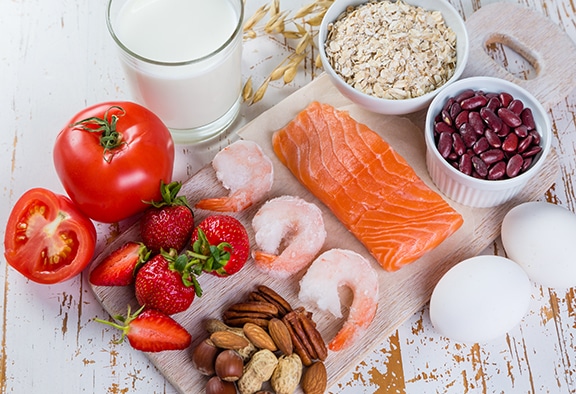
What is the difference between a food allergy and food intolerance? For many people, it’s easy to assume these conditions are one and the same. But while they have some similarities, food allergies and food intolerances vary drastically in terms of causes, symptoms, and overall severity.
When you have any type of food allergy or intolerance, knowing your exact condition and how to deal with it is vital. And as you might expect, dealing with both food allergies and diabetes can further complicate matters. Here’s Advanced Diabetes Supply’s in-depth overview of diabetes and food allergies.
Food Allergies vs. Food Intolerance: What’s the Difference?
Understanding what separates a food allergy from a food intolerance can be challenging. Making things more confusing, the symptoms and signs associated with these conditions often overlap. However, these phrases don’t describe the same issue—and knowing what sets them apart is vital.
The main difference between food allergy and food intolerance is this: A food intolerance usually affects the digestive system, meaning you shouldn’t have to deal with truly serious symptoms. In fact, some people with food intolerances can safely eat limited amounts of the foods they are sensitive to.
On the other hand, “true” food allergies have an impact on the immune system. If someone has a food allergy, exposure to even a tiny amount of the food they are allergic to can result in severe or even life-threatening symptoms.
Causes of Food Allergies: Understanding the Immunological Response
Food allergies occur when your immune system accidentally identifies a particular food (or a substance found in foods) as a threat to your well-being. When that happens, the immune system tells cells in your body to deal with the situation by releasing the antibody known as immunoglobulin E (IgE).
When you eat the food in question again, your IgE antibodies will detect its presence and tell your immune system to release various chemicals into your bloodstream, including histamine. These chemicals are responsible for the symptoms associated with allergic reactions.
Causes of Food Intolerance: Enzyme Deficiencies and Beyond
If you have a food intolerance, several different factors could be involved. These include:
Enzyme deficiencies. In order to digest certain foods, you need sufficient amounts of various enzymes. To name one typical example, not having enough lactase could contribute to lactose intolerance.
Food additive sensitivities. Some people experience digestive problems and other issues when they consume specific food additives like sulfites, MSG, or coloring and preservative agents in foods. For example, sulfites are used to help preserve wine, canned goods, and dried fruit and can even cause asthma attacks in certain people.
Active compounds in foods like histamine. Foods rich in histamine include fermented foods, such as sauerkraut, aged cheese and red wine.
Common Food Allergens and Intolerances
All kinds of foods can cause allergies, whether you are living with diabetes or not. These eight foods are viewed as particularly serious allergens:
- Soybeans
- Wheat
- Peanuts
- Tree nuts
- Crustacean shellfish
- Fish
- Eggs
- Milk
Meanwhile, ingredients commonly associated with food intolerances include:
- Gluten
- Dairy
- Salicylates
- Caffeine
- Certain kinds of carbohydrates called FODMAPs
- Amines
- Fructose
- Sulfites
Following a diabetes diet is an essential part of managing diabetes, but food allergies and intolerances can complicate the process of building a diabetes diet that works for you. If you have diabetes food allergies or intolerances, let your healthcare team know.
Lactose Intolerance in Diabetes: Exploring the Link
These days, type 2 diabetes is overwhelmingly the most common form of diabetes—up to 95 percent of people with diabetes have this variety of the disease. But unlike type 1 diabetes, people can lower their type 2 diabetes risk by making various lifestyle choices, such as watching what they eat.
A recent analysis of existing research determined that consuming certain dairy products like milk and yogurt might lower people’s type 2 diabetes risk. In fact, drinking 200g (almost a cup) of milk was linked to a 10 percent reduction in risk, while eating 100g (3.52 oz.) of yogurt was associated with a 6 percent lower risk.
There are quite a few drawbacks of lactose intolerance, and diabetes prevention benefits found in dairy can be harder to benefit from if you have this condition. But while lactose is naturally found in milk and dairy products, it doesn’t appear to be the source of these foods’ anti-diabetes properties. Instead, these benefits are apparently connected to the calcium, vitamins, and minerals found in milk. Because of that, lactose-intolerant people should be able to get similar perks from lactose-free milk and yogurt.
Gluten Intolerance and Diabetes: What You Need to Know

Gluten isn’t inherently harmful to people living with diabetes. But if you have type 1 diabetes, you’ll also have an increased risk of celiac disease—a condition that can seriously damage a person’s intestines and can prevent people from absorbing nutrients normally. An estimated 6 percent of people with type 1 diabetes also live with celiac disease. In contrast, just 1 percent of the general population has this condition.
Because of this, people with type 1 diabetes should get screened for celiac disease when they’re diagnosed and again at the two-year and five-year marks. If you experience symptoms of celiac disease or have a first-degree relative living with this condition, you may need additional screening.
While celiac disease must be treated by switching to a lifelong gluten-free diet, you can have difficulties consuming gluten without having full-blown celiac disease. This is known as “gluten intolerance” or “gluten sensitivity,” and it shares symptoms with celiac disease but does not cause intestinal damage. People with gluten intolerance and diabetes can still benefit from a gluten-free diet, but you should talk to your dietician before making any significant changes to your diabetes diet.
Symptoms of Food Allergies and Intolerances in Diabetes
Food allergy symptoms can appear from minutes to hours after you consume an allergen. Some common food allergy symptoms include:
- Rashes/flushed skin
- Hives
- Swelling of the lips, tongue, or face
- A tingly or itchy sensation in the mouth
- Abdominal cramping
- Diarrhea or vomiting
- Lightheadedness or dizziness
- Wheezing and coughing
- Trouble breathing
- Vocal cord/throat swelling
- Loss of consciousness
Food intolerances can also trigger several of the symptoms listed above. However, this is not considered a life-threatening condition—and as such, the symptoms associated with food intolerances tend to be milder than the symptoms associated with allergies.
Diagnosing Food Allergies and Intolerances in Diabetes
Do you suspect you have a true food allergy? If so, you could be asked to complete a so-called “challenge test,” which involves consuming a tiny amount of the substance you are potentially allergic to. However, you should never attempt to try this testing method on your own. Since food allergies can cause anaphylaxis, an allergist or physician should always supervise these tests.
If you think you have a lactose intolerance problem, you could take a hydrogen breath test. This test involves drinking a liquid containing lactose and breathing into a container every half hour for multiple hours. If you’re intolerant to lactose, your breath will contain high levels of hydrogen (and you might develop symptoms from drinking the liquid used in the test).
Unfortunately, there aren’t any similar tests for food intolerances like histamine intolerance and gluten sensitivity. Instead, you might be tasked with maintaining a food diary to watch your food intake and symptoms. You could also try an elimination diet to temporarily remove certain foods from your diet and see how that affects your symptoms.
Management Strategies for Food Allergies and Intolerances in Diabetes
Right now, food allergies and intolerances cannot be cured. The simplest, most effective way to handle these conditions is to avoid any allergens you are sensitive to. To accomplish this, you’ll need to carefully read ingredient labels, avoid cross-contamination when preparing meals at home, and ask your server about potential allergens at restaurants.
If you accidentally consume a food you are intolerant to, antihistamines can make managing any associated hives and itching easier. On the other hand, you’ll need an epinephrine injection to mitigate the symptoms of a severe food allergy. Because of this, many people with severe allergies are encouraged to carry an epinephrine autoinjector device wherever they go.
Can Diabetes Cause Food Allergies or Intolerances?
Since both food allergies and diabetes have become increasingly common as of late, it’s easy to wonder if and how these conditions are related. A 2022 study that appeared in the scientific journal Foods explored this assumption by modeling food allergies and diabetes in populations of mice. This study found that food allergies might interact with diabetes.
Of course, this isn’t the only research focusing on the intersection between diabetes and food allergies. For instance, Type 1 diabetes appears to come with a higher rate of self-reported IgE-mediated allergy symptoms. Also, children with allergies to cow’s milk may have an increased risk of type 1 diabetes. That doesn’t necessarily mean the answer to “can type 1 diabetes cause lactose intolerance?” or vice-versa is an unqualified yes—just that there appears to be a correlation between the two conditions.
Are you asking yourself, “can diabetes cause food intolerance?” If so, you should know that diabetes and celiac disease appear to have some similarities —meaning that this intolerance could contribute to diabetes.
Get The Diabetes Supplies You Need
Creating a diabetes diet is a significant undertaking for anyone, but balancing this process with food sensitivity issues can make things even more complicated. Being able to answer the question, “what is the difference between food allergy and food intolerance?” is an excellent first step. From there, understanding which of these conditions you have and taking steps to deal with your situation will help you and your healthcare team build a diet accounting for diabetes food allergies.
Once you have a diabetes diet that meets your needs, you can focus on other elements of your diabetes management strategy, like finding a reliable source of diabetes supplies. Nothing beats the convenience of ordering continuous glucose monitors, insulin pumps, and other supplies online, but you’ll need to get these products from the right supplier. Advanced Diabetes Supply is the industry’s most trusted source for these supplies and more—place your order today!
